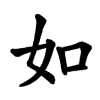Definify.com
Definition 2025
字
字
| ||||||
|---|---|---|---|---|---|---|
Translingual
| Stroke order | |||
|---|---|---|---|

| |||
Han character
字 (radical 39 子+3, 6 strokes, cangjie input 十弓木 (JND), four-corner 30407, composition ⿱宀子)
References
- KangXi: page 277, character 18
- Dai Kanwa Jiten: character 6942
- Dae Jaweon: page 545, character 7
- Hanyu Da Zidian: volume 2, page 1010, character 2
- Unihan data for U+5B57
Chinese
|
simp. and trad. |
字 | |
|---|---|---|
Glyph origin
| Historical forms of the character 字
| ||
|---|---|---|
| Bronze inscriptions | Large seal script | Small seal script |
 |
 |
 |
| Characters in the same phonetic series (子) (Zhengzhang, 2003) | |
|---|---|
| Old Chinese | |
| 孜 | *ʔslɯ |
| 仔 | *ʔslɯ, *ʔslɯʔ |
| 孖 | *ʔslɯ, *zlɯs |
| 子 | *ʔslɯʔ |
| 虸 | *ʔslɯʔ |
| 耔 | *ʔslɯʔ |
| 秄 | *ʔslɯʔ |
| 杍 | *ʔslɯʔ |
| 籽 | *ʔslɯʔ |
| 字 | *zlɯs |
| 茡 | *zlɯs |
| 芓 | *zlɯs |
| 牸 | *zlɯs |
| 李 | *rɯʔ |
Phono-semantic compound (形聲, OC *zlɯs) : semantic 宀 (“roof”) + phonetic 子 (OC *ʔslɯʔ, “child”).
Etymology
From Proto-Sino-Tibetan *tsa ~ za (“child; to give birth; to take care; to be kind”). Related to:
- 子 (OC *ʔslɯʔ, “child, son”) (also its phonetic component)
- 慈 (OC *zɯ, “to be kind, loving”)
- 滋 (OC *ʔsɯ, “to nourish, to grow”)
- 詞 (OC *ljɯ, “word, term”)
- 辭 (OC *ljɯ, “word, from testimony”)
Original sense (1): “to become pregnant, to give birth to, to nurture, to love” has essentially become obsolete. The sense (2) “letter, character” is either from a different root or a derivation from the sense “to produce, to generate”.
Cognate with Tibetan ཚ་བོ (tsha bo, “nephew”), Tibetan ཚ་རུས (tsha rus, “descendant”), Tibetan བཙའ་བ (btsa' ba, “to give birth to; to guard”), Tibetan མཛའ་བ (mdza' ba, “kind, peaceful, friendly”) (Quan, 1996).
Pronunciation
- Mandarin
- Cantonese (Jyutping): zi6
- Hakka (Sixian, PFS): sṳ
- Min Dong (BUC): cê
- Min Nan (POJ): lī / jī / chū / chīr / jū
- Wu (Wiktionary): zr (T3)
- Mandarin
- (Standard Chinese, Beijing)+
- Pinyin:
- Zhuyin: ㄗˋ
- Wade-Giles: tzu4
- Gwoyeu Romatzyh: tzyh
- IPA (key): /t͡sz̩⁵¹/
-

- (Standard Chinese, Beijing)+
- Cantonese
- (Standard Cantonese, Guangzhou)+
- Jyutping: zi6
- Yale: jih
- Cantonese Pinyin: dzi6
- IPA (key): /t͡siː²²/
- (Standard Cantonese, Guangzhou)+
- Hakka
- (Sixian, incl. Miaoli and Meinong)
- Pha̍k-fa-sṳ: sṳ
- Hakka Romanization System: sii
- Hagfa Pinyim: si4
- IPA: /sɨ⁵⁵/
- (Sixian, incl. Miaoli and Meinong)
- Min Dong
- (Fuzhou)
- Bàng-uâ-cê: cê
- IPA (key): /t͡sɛi²⁴²/
- (Fuzhou)
- Min Nan
- (Hokkien: Xiamen, Quanzhou, mainstream Taiwanese)
- Pe̍h-ōe-jī: lī
- Tâi-lô: lī
- Phofsit Daibuun: li
- IPA (Xiamen): /li²²/
- IPA (Quanzhou): /li⁴¹/
- IPA (Taipei): /li³³/
- IPA (Kaohsiung): /li³³/
- (Hokkien: Zhangzhou, Kaohsiung)
- Pe̍h-ōe-jī: jī
- Tâi-lô: jī
- Phofsit Daibuun: ji
- IPA (Zhangzhou): /d͡ʑi²²/
- IPA (Kaohsiung): /d͡ʑi³³/
- (Hokkien: Xiamen)
- Pe̍h-ōe-jī: chū
- Tâi-lô: tsū
- Phofsit Daibuun: zu
- IPA (Xiamen): /t͡su²²/
- (Hokkien: Quanzhou)
- Pe̍h-ōe-jī: chīr
- Tâi-lô: tsīr
- IPA (Quanzhou): /t͡sɯ⁴¹/
- (Hokkien: Zhangzhou)
- Pe̍h-ōe-jī: jū
- Tâi-lô: jū
- Phofsit Daibuun: ju
- IPA (Zhangzhou): /d͡zu²²/
-

- Note: lī/jī - vernacular; chū/chīr/jū - literary.
- (Hokkien: Xiamen, Quanzhou, mainstream Taiwanese)
- Wu
- (Shanghainese)
- Wiktionary: zr (T3)
- IPA (key): /z̻z̩²³/
- (Shanghainese)
- Dialectal data▼
| Variety | Location | 字 |
|---|---|---|
| Mandarin | Beijing | /t͡sz̩⁵¹/ |
| Harbin | /t͡sz̩⁵³/ | |
| Tianjin | /ye⁵³/ | |
| Jinan | /t͡sz̩²¹/ | |
| Qingdao | /t͡sz̩⁴²/ | |
| Zhengzhou | /t͡sz̩³¹²/ | |
| Xi'an | /t͡sz̩⁴⁴/ | |
| Xining | /t͡sz̩²¹³/ | |
| Yinchuan | /t͡sz̩¹³/ | |
| Lanzhou | /t͡sz̩¹³/ | |
| Ürümqi | /t͡sz̩²¹³/ | |
| Wuhan | /t͡sz̩³⁵/ | |
| Chengdu | /t͡sz̩¹³/ | |
| Guiyang | /t͡sz̩²¹³/ | |
| Kunming | /t͡sz̩²¹²/ | |
| Nanjing | /t͡sz̩⁴⁴/ | |
| Hefei | /t͡sz̩⁵³/ | |
| Jin | Taiyuan | /t͡sz̩⁴⁵/ |
| Pingyao | /t͡sz̩³⁵/ | |
| Hohhot | /t͡sz̩⁵⁵/ | |
| Wu | Shanghai | /zz̩²³/ |
| Suzhou | /zz̩³¹/ | |
| Hangzhou | /zz̩¹³/ | |
| Wenzhou | /zz̩²²/ | |
| Hui | Shexian | /t͡sʰz̩²²/ |
| Tunxi | /t͡sʰz̩¹¹/ | |
| Xiang | Changsha |
/t͡sz̩⁵⁵/ /t͡sz̩¹¹/ |
| Xiangtan | /d͡zz̩²¹/ | |
| Gan | Nanchang | /t͡sʰz̩²¹/ |
| Hakka | Meixian | /sz̩⁵³/ |
| Taoyuan | /sï⁵⁵/ | |
| Cantonese | Guangzhou | /t͡si²²/ |
| Nanning | /t͡sz̩²²/ | |
| Hong Kong | /t͡si²²/ | |
| Min | Xiamen (Min Nan) |
/t͡su²²/ /li²²/ |
| Fuzhou (Min Dong) | /t͡sɛi²⁴²/ | |
| Jian'ou (Min Bei) | /t͡si⁴⁴/ | |
| Shantou (Min Nan) | /zi³¹/ | |
| Haikou (Min Nan) |
/t͡si³³/ /tu²³/ 訓書 |
| Rime | |
|---|---|
| Character | 字 |
| Reading # | 1/1 |
| Initial (聲) | 從 (15) |
| Final (韻) | 之 (19) |
| Tone (調) | Departing (H) |
| Openness (開合) | Open |
| Division (等) | III |
| Fanqie | 疾置切 |
| Reconstructions | |
| Zhengzhang Shangfang |
/d͡zɨH/ |
| Pan Wuyun |
/d͡zɨH/ |
| Shao Rongfen |
/d͡zieH/ |
| Edwin Pulleyblank |
/d͡zɨH/ |
| Li Rong |
/d͡ziəH/ |
| Wang Li |
/d͡zĭəH/ |
| Bernard Karlgren |
/d͡zʱiH/ |
| Expected Mandarin Reflex |
zì |
| Baxter-Sagart system 1.1 (2014) | |
|---|---|
| Character | 字 |
| Reading # | 1/1 |
| Modern Beijing (Pinyin) |
zì |
| Middle Chinese |
‹ dziH › |
| Old Chinese |
/*mə-dzə(ʔ)-s/ |
| English | breed, love (v.); character |
Notes for Old Chinese notations in the Baxter-Sagart system: * Parentheses "()" indicate uncertain presence; | |
| Zhengzhang system (2003) | |
|---|---|
| Character | 字 |
| Reading # | 1/1 |
| No. | 17864 |
| Phonetic component |
子 |
| Rime group |
之 |
| Rime subdivision |
0 |
| Corresponding MC rime |
字 |
| Old Chinese |
/*zlɯs/ |
| Notes | 子分化字 |
Definitions
字
- † to give birth to; to deliver a baby; to bring into the world
- † to be pregnant; to be carrying a baby
- †(historical, of a girl) to be betrothed; to be allowed to marry
- † to bring up; to raise; to rear (a child)
- † to love; to cherish; to care very much for
- † to educate; to teach; to instruct
- † to govern; to administer
- Chinese character; hanzi (Classifier: 個/个)
- word; term; wording; diction
- (computing) word
- handwriting; writing
- (historical) courtesy name; Chinese-style name (a name traditionally given to Chinese males at the age of 20)
- (historical) to style; to give someone a courtesy name
- letter; symbol; character
- (calligraphy) style of handwriting; printing type
- (calligraphy) (a calligrapher's) calligraphy work
- written letter; message; correspondence
- receipt; contract; slip
- pronunciation of a character; pronunciation
- (Cantonese) five minutes (derived from the locations of 1 to 12 on a clock face)
- 三個字 / 三个字 [Cantonese] ― saam1 go3zi6 [Jyutping] ― fifteen minutes [i.e. when the minute hand points to 3]
-
- 而家係一點十一個字。 [Guangzhou Cantonese, trad.]
- 而家系一点十一个字。 [Guangzhou Cantonese, simp.]
- Ji4 gaa1 hai6 jat1 dim2 sap6 jat1 go3zi6. [Jyutping]
- It's five to two now. (Literally: It's one o'clock [and] eleven five-minutes.)
-
- 爭三個字到六點 [Guangzhou Cantonese, trad.]
- 争三个字到六点 [Guangzhou Cantonese, simp.]
- zaang1 saam1 go3zi6 dou3 luk6 dim2 [Jyutping]
- a quarter to six (Literally: Missing three five-minutes to six o'clock)
- A surname.
Compounds
|
|
|
Descendants
Others:
- Proto-Tai: *ɟɤ:ᴮ (“name”)
- Vietnamese: chữ (“script; letter; writing; word”)
Japanese
Kanji
Readings
Compounds
- 十字 (jūji): cross
- 字解 (jikai)
- 字義 (jigi): the meaning of a word
- 字源 (jigen): the construction of a character
- 字体 (jitai): font or lettering
- 字典 (jiten): character dictionary
- 字母 (jibo): letter (of the alphabet)
- 漢字 (kanji): Chinese characters
- 漢字返し (漢字返shi) kanji repeater
- 文字 (moji): letter, character, or ideograph
- 字引 (jibiki): dictionary
- 数字 (sūji): numeral or number
- 字訳 (jiyaku)
- 二字 (niji): two characters
- 大字 (daiji): a large character
Etymology 1
| Kanji in this term |
|---|
| 字 |
|
じ Grade: 1 |
| on'yomi |
Borrowed from Middle Chinese 字 with the southern pronunciation (kango, Go-on).
Pronunciation
Noun
- a letter, character
- この字は何と読みますか?
- Kono ji wa nan to yomimasuka?
- How do you pronounce this character?
- この字は何と読みますか?
- handwriting
- 彼女は字が上手い。
- Kanojo wa ji ga umai.
- She has good handwriting.
- 彼女は字が上手い。
Counter
- letters, characters
- 40字以内で書いてください。
- Yon jū ji inai de kaite kudasai.
- Please write it down in 40 letters or fewer.
- 40字以内で書いてください。
Etymology 2
| Kanji in this term |
|---|
| 字 |
|
あざ Grade: 1 |
| kun'yomi |
Shortened form of あざな azana "a section of a village" of ancient Japanese origin (wago).
Pronunciation
Noun
Derived terms
Etymology 3
| Kanji in this term |
|---|
| 字 |
|
あざな Grade: 1 |
| kun'yomi |
Of ancient Japanese origin (wago).
Pronunciation
Noun
字 (hiragana あざな, romaji azana)
- courtesy name
- nickname
- a section of a village
References
- 1 2 3 2006, 大辞林 (Daijirin), Third Edition (in Japanese), Tōkyō: Sanseidō, ISBN 4-385-13905-9
- 1 2 3 1998, NHK日本語発音アクセント辞典 (NHK Japanese Pronunciation Accent Dictionary) (in Japanese), Tōkyō: NHK, ISBN 978-4-14-011112-3
Korean
Hanja
字 • (ja)
Eumhun:
- Sound (hangeul): 자 (McCune-Reischauer: cha)
- Name (hangeul): 글자()
- This term needs a translation to English. Please help out and add a translation, then remove the text
{{rfdef}}.
Vietnamese
Han character
- This term needs a translation to English. Please help out and add a translation, then remove the text
{{rfdef}}.
References
- Thiều Chửu : Hán Việt Tự Điển, Hà Nội, 1942
- Trần Văn Chánh: Từ Điển Hán Việt NXB Trẻ, Ho Chi Minh Ville, 1999
- Vũ Văn Kính: Đại Tự Điển Chữ Nôm, NXB Văn Nghệ, Ho Chi Minh Ville, 1999